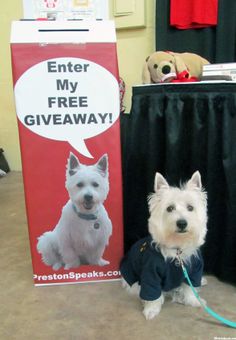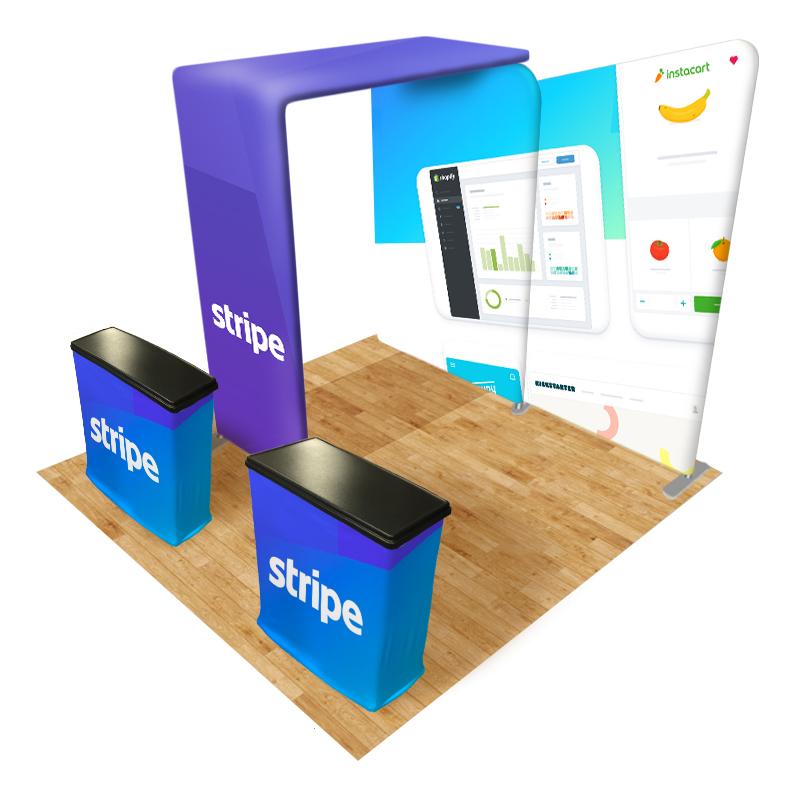This guide is for anyone who isn’t quite sure where to start when it’s your and your company’s first time ever sponsoring a trade show booth.
For those of you who have never managed a booth activation at a trade show, the biggest thing to know is that costs can add up quickly. From the materials to own the booth to shipping to drayage, you’ll easily be in the tens of thousands of dollars if you want to represent your brand in a well presented, sophisticated manner.
Here are some simple steps to get you on your way to planning for a booth and also, some things to definitely look out for.
Before the event
1) Read the contract and guidelines for your booth carefully.
Each trade show is always little different. Venues like to ouse preferred vendors such as booth builders, AV providers.
Make sure you know how the location of your booth is chosen. If there is a “start” date – do this as early as possible. Booth placement in the show floor is critical to your success. Make sure you’re either centrally located or up front near the entrances. If there are multiple entrances, check to see where other events are happening at the conference and identify the best entryway. Another thing to check with the event coordinators are if any of your competitors intend to be there and ensuring that you are not directly next to them. It will be distracting for you and your staff if this occurs.
To keep on track – checklists are great, but make sure you have some system that works for you.
2) Establish a purpose for your booth.
Is this all about brand awareness? Are you just trying to generate leads? Is the booth to host meetings? Either way, it’ll be good to set some small goals for yourselves.
If brand awareness is a big objective, make sure your booth represents your brand in the best way possible. Invest in design. Invest in having a “draw” to the booth that brings people in to check it out.
If it’s to generate leads, this is similar to having a “draw” to the booth. This could mean some sort of centerpiece that may or may not be interactive (I have seen giant video display walls that stop people in their tracks), great giveaways or a contest/raffle, and if your brand allows for it, something a bit more gimmicky, like a cash booth, spinning wheel for prizes, or even puppies*.

And most importantly for lead gen – make sure you have a lead gen plan. Who will collect and qualify, how you will pass them off, and how will they get into your CRM to track (and how they will be tagged). Doing this ahead of time will save you tons of heartache.
If your booth is being used to host meetings – making sure you have a schedule for this is critical – and a comfortable space. Determine if you want a lower seated table or a tall table withs tools. Do you want seats, or is this to stand with to demo? How many people will meet at one time, and do you have enough room. Meeting in the booth can be incredibly difficult, so make sure you also scope out back-up space nearby if it doesn’t work out.
*While I love puppies, unless your dog’s temperament works with a big crowd, this can be very stressful on an animal – no matter how cute you may think this is, so do this responsibly.
3) Set your budget.
Keeping within budget for your booth will be nearly impossible your first time out the door. Keep this in mind and keep your stakeholders informed of this expectation. Be as generous as possible.
Make sure to account for the following:
Booth build, furniture rental, and booth supplies
(See below “4) Determine what type of booth you want to implement” for guidance to determine how to price this out)
Shipping
This cost is probably what hurts your budget the most in a way you wouldn’t expect. If you have everything you need ready to go in only one or a few freight packages – ship freight, and ship early. If you are scrambling last minute, you will end up spending hundreds of dollars getting creative with what you ship. Don’t forget, it’s not about getting the stuff there, but also shipping stuff back.
You can generally ship directly from the venue, but you will want to print your “bill of lading” (the list you provide to the trade show management vendor of all your items) before you even get to the show.
If you know the weight of your items, printing labels in advance can be very useful. If your event is in a local venue, print labels for couriers and make sure you have space to list “Package ___ of ___” so you can fill in the blanks after the event.
Pro-tip: You can ship to a UPS or FedEx as a shipping location & pay a nominal pick-up fee (often $5-15 per package) to avoid any drayage costs of the show venue handling your packages. The downside is that you have to drag everything to the venue.
Materials handling at the venue (set-up and clean-up) or by the conference vendor – aka drayage.
Everything either the vendor handles has a cost associated. This could be by the number of shipments, of weight, you name it. Additionally there are generally differences in cost depending on the “deadline” to ship to the vendor’s warehouse versus shipping directly to the venue. Most venues won’t open up receiving until a few days before (which is why vendors generally want you to ship to their warehouse, although the deadline generally closes a few days before the event so they can get all the packages to the venue itself).
Make sure you review what the associated costs are. If you don’t plan this carefully the cost of drayage can be in the thousands.
Electricity, wi-fi, AV
Check the conference organizer’s guides, but if you need electricity or AV equipment at the booth, make sure you order this. It’s often through the hotel’s vendor. If you need wifi, check the speeds. It can be exorbitant, but depending on what you are doing, necessary. Often times a jetpack or the conference public wifi will work just as well if it’s just for staff to have access.
Pro-tip: To avoid this… you can be a bit sneaky and do all of the handling yourself. This means, you and your team doing the manual labor. Not recommended but a good way to see how a show goes the first time a around if you want it to be low risk. (although if your competitors are paying others to do the work and they see you doing it yourself, it does make you look “small” or like you don’t have the money to afford the service – so beware!)
4) Determine what type of booth you want to implement
Absolutely easier said than done. Do you want something custom? Pre-fab? Mobile? What’s your budget?
Booth build
Building a booth can be as simple as doing something pre-fab and mobile (example: BoothPop).

The pro’s to going this route is that they are inexpensive, easy to ship, and relatively simple to put together yourself (or with the help of a few people). The con’s can be that everyone else has highly professional booths around you that outshine yours, the pre-fab booth becomes difficult to put together and take apart yourself, you could lose a piece or two and it’s rendered mostly useless then.
Building a professional booth to keep is an investment. Then having it shipped to and from the venue is costly, not to mention needing a place to store it. Booths like this should only be an investment if you intend to do multiple conferences. Make sure you purchase a standard size and/or purchase a booth that has flexibility to expand or become smaller. And note, simple and clean is often better than very custom.
Building a once and done booth should only be an investment at a major show. This decision is made when you know you have made significant investment to be a major sponsor at the event and need to put your money to work. Ensure you have the right vendor who has experience working with the conference organizers or at least in the venue or area (especially if it’s in another country). Often times, because of how unions are organized – especially internationally – picking the wrong vendor could cost you more headache than just going with whomever the organizers or venue recommends. The process of building a booth with these vendors varies from vendor to vendor, so make sure you have the proper conversations and prepare your questions ahead of time.
Pro-tip: Make sure the booth has good lighting. Trade show lighting is the worst, so ensure your booth has some sort of light source – whether it’s on from the top of your backdrop, or as a spotlight on the ground.
Furniture rental
Easily the most ridiculously expensive part of a booth. You may want chairs, a table, some lighting, maybe even a trash can. All of these things cost money!
To give you an idea if you decide to rent: chairs can cost upwards of $200-500 EACH depending on the style. But note, you rent because you’re paying for the convenience of not having to ship your own and install/remove.
Bringing your own furniture can sound cost effective – especially if you intend on doing multiple shows, but again, this is not fun. If you intend to ship freight (see below: Shipping), this could work in your favor, but remember freight only works if you have everything ready to go in one (or just a few) shipment(s).
If you are figuring things out last minute and need to ship many things separately or want to buy things in the city the trade show is in, be warned. I have personally purchased brand new furniture (or ordered online) in the city of the trade show and had to put together and remove it all – then decide if it was worth the value to ship it back home or donate it all (donating it was more cost effective).
So moral of the story, choose wisely. Most vendors don’t have a wide selection either, so you’re limited to what’s available – so choose simply.
Also, don’t forget to think about flooring or carpet. Trade show floors tend to be hideous.
Booth supplies
Answering the following questions will help you determine what you may need to order:
- How will your collateral (brochures, one pagers, etc) be displayed?
- Do you need any giveaways?
- How will your giveaways be displayed?
- Do you need any additional signage?
- Do you need a way to capture business cards or display business cards?
Drawing out the space of your booth and how you will display your items is a helpful way to keep on track. If you have anyone experienced with renderings, someone should render a mock of your booth so you know if you’ll have enough room for everything and be comfortable.
Pro-tip: If this is a multi-day show, you may want to lock things up overnight. Make sure you have a plan for this. Whether it’s a locked box, locked cabinet, or even literally locking things together. Furniture tends to be fine, I mean valuables like iPads for check-ins – or take it with you.
5) Pack useful supplies to use at the event
Having a box cutter or Swiss army knife on hand is useful during set-up and take down. Make sure you have some packing tape (for packing up stuff to ship home if you’re doing this yourself). A sharpie and pen is handy for filling out any labels or signage. If the electricity didn’t come with a power strip, it’ll be very useful to have one on hand. Other misc things that could be useful include zip ties (if you have Pelican cases that need to be locked up), safety pins (for those weird moments you just really need one), and of course, hand sanitizer for the number of times you’ll be shaking hands.
6) Remind your team
Make sure they bring their business cards and the clothing you want them to wear to represent the business. Stylish, comfy shoes, a plus.
At the event
1) Give yourself enough time to set-up
Overestimate how much time you need to set-up. Even if you have hired someone to do this for you, get to the venue early enough to make sure that it is indeed underway. Make sure you check for missing items – just in case you need to run and purchase something last minute
2) Give your team role assignments
Have a plan for what everyone is there to do, and enforce those rules. Otherwise, you’ll have a bunch of people on their phones and your booth will be passed over / ignored. Having someone at the front friendly greet and qualify, and another person within the booth to receive and continue the convo.
Someone should be collecting the business cards or scanning the name tags (if that’s an option).
Pro-tip: Try not to be a creeper and stare at everyone’s name tags OR get into people’s faces. No one likes an overeager sales person.
After the event
1) Return Shipping
If you intend on shipping things back yourself, packing things in as few boxes and determining if the value versus weight ratio is worth the cost of shipping is key.
Otherwise, just make sure you have your bill of lading so that the return shipment team can ensure everything you want sent back is actually, well sent back.
2) Tallying the costs
Don’t be shocked if you’re over budget. If you’re under, amazing work! I highly recommend doing this ASAP so that you get the most accurate number, because who knows if you need to find a receipt because you forgot to add it to your collection!
Of course, this is in no way completely covering everything that could happen, but I tried to be as comprehensive as possible. For seasoned events veterans, we all know there are a million things that could happen that may not be covered here, so please feel free to comment or ask any questions!
Header Photo by britt gaiser on Unsplash
